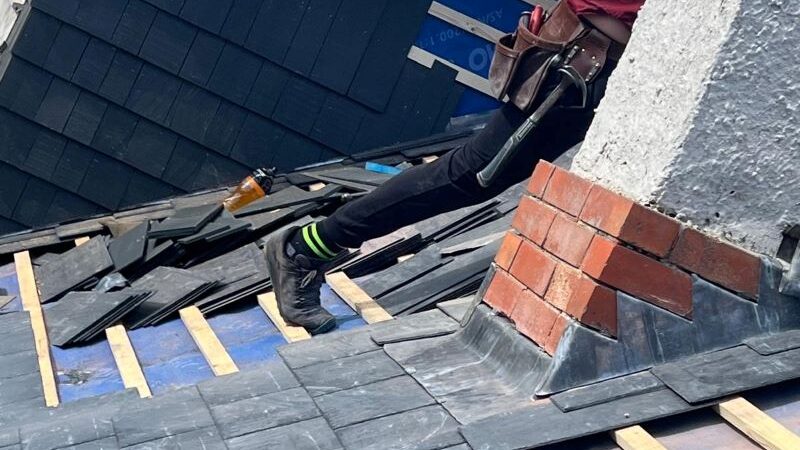Maximize Your Slate Roof’s Lifespan by Implementing Effective Flashing to Prevent Costly Water Damage
Flashing acts as an essential protective barrier at the most vulnerable areas of your roof, especially where tiles meet walls, chimneys, or valleys. Without proper flashing installation, even the most expertly crafted slate roof can succumb to leaks, leading to expensive repairs over time. Lead is favored for flashing in slate roofing because of its unique flexibility, outstanding durability, and its ability to adapt to the natural movements of the roof framework, thereby ensuring a robust seal that effectively prevents water penetration.

Understanding Flashing: Its Role and Importance in Maintaining Your Slate Roof’s Structural Integrity
Flashing is a crucial material used to seal joints and edges around elements like chimneys, skylights, roof valleys, and any intersections where your slate roof meets a wall or changes direction. These joints are particularly prone to water infiltration, and without effective flashing, they are likely to be the first areas that fail, resulting in leaks. In modern construction, flashing can be made from various sheet metals, but for traditional slate roof applications, lead remains the most reliable choice.
Why is lead the material of choice? This substance not only seals effectively but also adapts to create a strong barrier against various curves, slopes, and edges. It naturally expands and contracts with temperature changes without the risk of cracking or splitting. Unlike synthetic materials, lead does not rust and retains its structural integrity for an extended period, often lasting longer than the slate itself.
Understanding the Potential Consequences of Ineffective Flashing on Your Slate Roof
Even the slightest tear or gap in your flashing can result in significant leaks. These leaks are often complex; water can seep beneath the tiles, reach the underlay, and gradually cause issues such as rot, mold, or damage to your interior ceilings. The effects of flashing failure may not be immediately noticeable, often taking years to surface, leading to extensive and costly repairs. Problems associated with flashing are among the leading causes of hidden roof failures.
If you notice stains on your ceiling, bubbling paint near a chimney, or patches of moss accumulating in specific areas on your roof, it is highly likely that deteriorating flashing is the underlying issue.
Discover Why Lead Remains the Optimal Choice for Flashing in Slate Roof Installations
For centuries, lead has been the material of choice for slate roofs due to its unmatched properties. It is recyclable, incredibly durable, and resilient against harsh weather conditions, whether faced with extreme heat or severe storms. The malleability of lead allows it to conform snugly without risking damage to the delicate slate, which is relatively fragile in comparison to lead.
Common applications for lead flashing include:
- Chimney flashings (including both step and apron)
- Roof valleys
- Secret gutters
- Roof-to-wall junctions
- Ridge and hip intersections
- Surrounds for skylights
These crucial areas experience movement, pressure, and water runoff, making them particularly vulnerable to failure when constructed with hard, inflexible materials that may crack or dislodge.
Identifying the Right Time to Replace or Repair Your Lead Flashing
While lead flashing is typically long-lasting, it will eventually show signs of wear and tear. You should consider replacement if:
- The lead exhibits splits or cracks
- It is lifting or curling away from the roofline
- Visible rust is present, especially where lead interfaces with other metals
- Water stains are apparent inside your home
- You are already planning a slate roof repair or replacement
Most slate roof restorations include a comprehensive inspection of all leadwork. If we are already on your roof for tile replacement or cleaning, that is the optimal time to evaluate and replace flashing as necessary.
Why It’s Essential to Trust Leadwork to Experienced Professionals
Leadwork is a specialized trade that should not be left to just any general roofer or handyman. Improperly installed lead can sag, crack, or detach from the slate, undermining the benefits of a well-constructed slate roof. Our skilled team uses traditional methods for installing lead flashing, ensuring proper sizing, correct lap joints, and expansion joints that accommodate the weather fluctuations common in Sydney. We are dedicated to utilizing lead only where it is the most suitable material for the job at hand.
How Quality Flashing Can Prevent Future Roofing Problems
A slate roof can remain functional for a century or more, but only if its most vulnerable points are adequately safeguarded. Flashing and leadwork may not be the most glamorous elements of a roof, yet they are indispensable components that take on the brunt of harsh weather conditions. If you observe leaks, streaks, or signs of deterioration around your chimney or roof edges, it’s crucial to have it inspected promptly. Replacing flashing now can save you from incurring significantly higher repair costs for structural damage later on.
Are You Looking for a Professional Inspection of Your Leadwork?
If your slate roof features aging flashing that displays signs of wear, it is wise to have it evaluated before minor concerns escalate into major problems. Contact us today to schedule an inspection with a team that specializes in slate, lead, and the intricate details that effectively ensure your roof’s integrity.
Frequently Asked Questions Regarding Flashing and Leadwork on Slate Roofs
What is flashing on a slate roof and why is it essential?
Flashing is the material utilized to seal joints and transitions in the roofing system—such as around chimneys, valleys, and skylights—preventing water from infiltrating the roofing structure.
Why is lead the preferred choice for flashing on slate roofs?
Lead is flexible, exceptionally durable, and resistant to adverse weather conditions. It conforms to the contours of slate tiles and outlasts synthetic materials, making it the ideal option.
How long can you expect lead flashing to last under optimal conditions?
With proper installation, lead flashing can endure for over 50 years, frequently outlasting the slate roof it is designed to protect.
Is it possible to repair flashing without needing to replace the entire roof?
Absolutely, damaged or worn flashing can be repaired or replaced without necessitating a full slate roof replacement, as long as the issues are addressed in a timely manner.
What indicators suggest flashing failure?
Signs of flashing problems include water stains near chimneys, damage to ceilings, moss growth in isolated areas, or visible gaps where roof surfaces meet.
Do all slate roofs require lead flashing for optimal protection?
Most slate roofs require it. Areas such as chimneys, valleys, and wall junctions necessitate flashing, with lead being the material of choice due to its compatibility with slate.
Is it safe to use lead flashing in residential buildings?
Indeed, when installed by professionals, lead flashing poses no safety risks. It remains the most effective and traditional choice for slate roofs.
The Article: Leadwork and Flashing: Why It’s Crucial for a Slate Roof first appeared on https://writebuff.com
The Article Leadwork and Flashing: The Importance for Slate Roofs Was Found On https://limitsofstrategy.com
The Article Leadwork and Flashing for Slate Roofs: Why They Matter First Appeared ON
: https://ad4sc.com









No responses yet